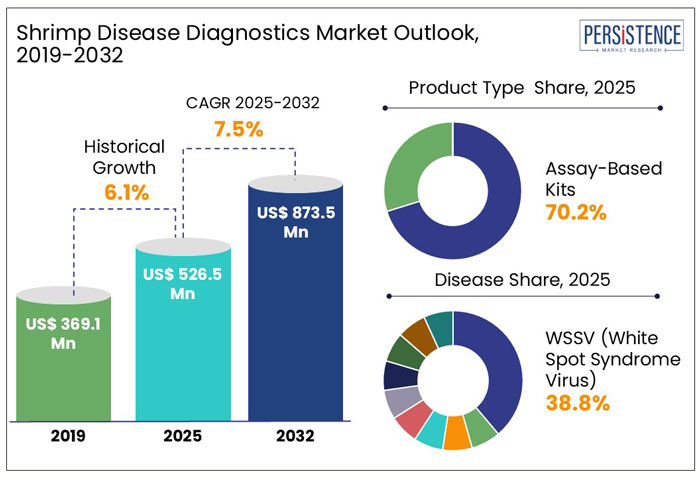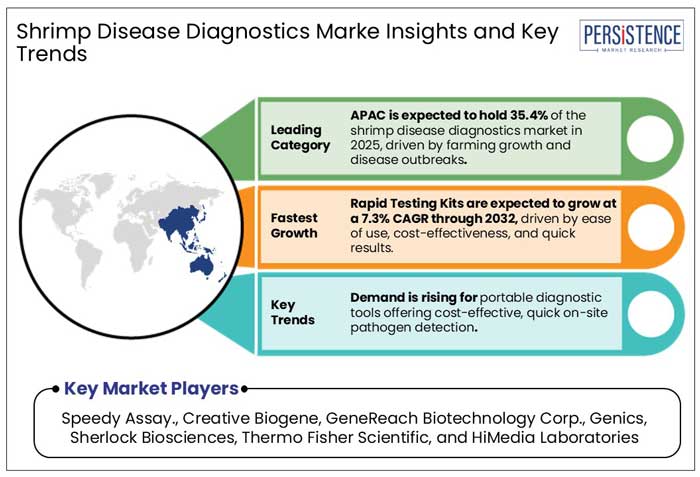Industry: Healthcare
Published Date: March-2025
Format: PPT*, PDF, EXCEL
Delivery Timelines: Contact Sales
Number of Pages: 215
Report ID: PMRREP29626
The Global revenue from the shrimp disease diagnostics market was about US$ 526.5 Million in 2025, with the global market expected to grow at a CAGR of 11.40% to reach a valuation of about US$ 1,121.0 Million by the end of 2032.

|
Market Size (2025) |
US$ 526.5 Million |
|
Projected Market Value (2032) |
US$ 1,121.0 Million |
|
Global Market Growth Rate (2025 to 2032) |
11.40% CAGR |
|
Market Share of Top 5 Countries (2024) |
52.1% |
As assessed by Persistence Market Research, assay based kits held a market share of around 71.4% in the global market, in 2024. Overall, shrimp disease diagnostics market sales account for around 12.8% of revenue share in the global animal diagnostics market, which was valued at around US$ 3.5 Billion in 2024.
The shrimp disease diagnostics market is a subset of the larger animal diagnostics market and is primarily driven by the increasing demand for shrimp globally. Shrimp is one of the most widely consumed seafood items in the world, and as such, the demand for shrimp has been steadily increasing over the past few years.
The global shrimp disease diagnostics market recorded a historic CAGR of 5.1% in the last 5 years from 2019 to 2024 due to due to increasing in viral borne diseases, advancement in molecular diagnosis tools, and growing shrimp food industry.
Diagnostic procedures for shrimp sickness usually involve taking samples from sick shrimp and examining them for the presence of infections or other abnormalities. Tissue, blood, and faeces are all examples of possible samples. Microscopy, polymerase chain reaction (PCR ), ELISA (enzyme-linked immunosorbent assay), and other laboratory techniques can be employed for diagnosis. PCR has been widely used to detect shrimp viruses, allowing disease risk to be controlled. PCR is a highly sensitive and robust technique for detecting pathogens in shrimp.
The important drivers of the shrimp disease diagnostics market include increasing demand for shrimp, rising awareness of disease management in shrimp farming, and the increasing prevalence of shrimp diseases. The market is also driven by the development of innovative diagnostic tools and the increasing availability of diagnostic services.
Shrimp is a well-known aquaculture species all over the world. Disease outbreaks in the previous two decades reduced shrimp production significantly. Early and accurate detection of acute infectious diseases in animals and humans is vital to effective and rapid response to manage control spread, outbreaks, and prevent loss of lives and working capital. Thus, analysis based on infectious disease epidemiology will benefit small industry players.
Availability of knowledge based resources and enhanced research collaborations tends to improve the product development for early diagnosis and prevention of infectious diseases. Continuous investment in product development have led to commercialization of shrimp disease diagnostic kits with the ability to incorporate multiple disease detection, which can be used in disease diagnosis tests, for achieving faster analysis.
“Diagnostics Provide Biosecurity of Shrimps and Prevent Infectious Diseases Spread”
The growing requirement for shrimp aquaculture farming for human food and nutrition supply is expected to drive the global acceptance of shrimp disease diagnostics. The major driving factors are an increase in demand for marine shrimp aquaculture farming and freshwater, as well as increased global shrimp production. Shrimp disease diagnostics aid in the growth of healthy shrimps and the prevention of infectious diseases in humans.
Biosecurity of aquaculture encompasses broad concepts of strategic and integrated approaches that include the policy and regulatory frameworks to analyze and manage risks in the sectors of aquaculture food safety and quality, life and health of animals and plants, including associated environmental risk. Application of shrimp disease diagnostics will help to maintain the biosecurity of shrimp farming, food safety and quality, and sustainability of shrimp farming.
Even today, more than two decades of emergence of White Spot Syndrome (WSS), there is no therapeutic option available, and the only option available is to detect and restrict the pathogen entry in the hatchery and farm, using advanced diagnostic tools. Screening of viral pathogens using PCR and DNA hybridization laboratories by the farmers rendered biosecurity in shrimp farming, preventing the spread of devastating infectious diseases such as WSD of shrimp through early diagnosis and acceptance of BMPs (best management practices).
“Lack of Lab Technicians, Stringent Regulations, and Cost of Diagnostics Procedures”
The detection of WSS is often performed in centralized laboratories utilizing molecular biology techniques. However, this method of testing can be costly and time-consuming as it requires specialized lab space, highly skilled lab personnel, sophisticated technology, and long-distance sample transportation from the field to the lab. Diagnosticians and farmers can be able to control disease outbreaks from the pond side thanks to the increasing use of in-field diagnostics as tools for quick and early animal disease identification. The regulatory framework for shrimp disease diagnostics is still evolving in some countries, which can hinder market growth.
In Asia, populations of wild shrimp have been shown to contain viral infections that cause fatalities in aquaculture systems. Increased capacity to carry out quarantine, surveillance, and disease identification and management is required in developing nations that are significant producers of aquaculture shrimp in order to raise awareness of the risk of disease transmission associated with the importation of live animals for aquaculture. For example, some shrimp importing countries or regions (e.g., European Union) have adopted management regulations to protect crustacean domestic populations by adopting measures with respect of import of aquaculture animals, sustainable fisheries, and ecosystems.
Will the United States Be a Lucrative Market for Shrimp disease diagnostics?
“Easy Availability of Advanced Molecular Diagnostics Tools”
The United States market held about 9.0% market share of the global market in 2024 and it is anticipated to expand the global market due to advancement and easy accessibility of genetic tools.
The higher prevalence of infections, rising healthcare expenditure, implementation of favorable government initiatives, efficient healthcare infrastructures, easy access to technologically advanced instruments, and availability of skilled laboratory technicians all contribute to market growth in the United States In aquaculture America 2021 conference, the United States aquaculture society joined with National Aquaculture Association and the Aquaculture Suppliers Association for meetings regarding the sustainable aquaculture production and more attention to health management and diseases prevention.
Why is the China Market Booming?
“Government’s Regulations and Diagnostics to Control Infection Spread and Economic Losses”
The Chinese market held around 19.4% market share of the global market in 2024 due to avoidance of infectious diseases in shrimp and economic losses.
China is the world's largest consumer of seafood, and the demand for shrimp has been increasing in recent years. China is dominating for shrimp farming globally and diagnosing shrimp diseases to avoid any economic loss. Thus, it is also helpful to prevent spread of infections from seafood to humans.
The Chinese government has implemented regulations to ensure the safety and quality of seafood products, including shrimp. This has led to an increased demand for disease diagnostics to comply with these regulations. The diagnostic innovations (real-time PCR and ELISA assays) have increased the accuracy and speed of disease diagnosis, leading to increased adoption.
How is Germany Emerging as a Prominent Market?
“Large Seafood Farming Sector and Presence of Key Players”
Germany was holding a market share of about 1.1% of the global market in 2024 and it is expected to increase the global market due to seafood farming sector and presence of key players as a result greater availability of products and increased competition.
Germany was holding a market share of about 1.1% of the global market in 2024 and it is expected to increase the global market due to seafood farming sector and presence of key players as a result greater availability of products and increased competition.
Germany is one of the largest seafood markets in Europe, and the demand for shrimp has been increasing in recent years. This has led to a greater need for effective disease diagnostics to ensure the safety and quality of shrimp products. There has been an increase in the incidence of shrimp diseases such as white spot syndrome virus (WSSV), yellow head virus (YHV), and Taura syndrome virus (TSV), and in recent years.
Germany has a significant presence of key market players in the shrimp disease diagnostics market, which has resulted in a greater availability of products and increased competition.
Which Type of Reagent Kits is Driving Demand Within the Global Market?
“Assay Based Kits Have More Sensitivity and Reliability Over Rapid Testing Kits”
Assay based kits had about 71.4% of the global market in terms of spending in 2024 because of advantages of assay based kits over rapid testing kits.
Assay kits are widely used in environmental monitoring, drug discovery, and life science research. It can be used to analyze disease pathways, screen or pick potential drug leads, and assess the manufacturing procedures for biopharmaceuticals. Assay kits are safer, ready-to-use, and have user-friendly forms. They also have greater accuracy, sensitivity, and the ability to quickly filter results by detection target and species reactivity. Rapid testing kits, on the other hand, have lower sensitivity than lab tests, false negatives are common, and are unable to identify people who are asymptomatic.
Which Type of Disease is Driving Demand in the Global Market?
“Highly Contagious White Spot Syndrome Virus is Prevalent in Shrimp Farming”
By type of disease segment, WSSV is holding around 38.8% share of the global market in 2024 due to WSSV profoundly present in shrimp farming and is highly contagious as well.
WSSV is the only virus belonging to the genus Whispovirus. White Spot Disease (WSD) is caused by WSSV, which is also extremely important viral pathogen of cultivated shrimp. There is a large variety of potential hosts for this virus, such as crabs, crayfish, and lobsters.
This virus is very contagious and can spread vertically from infected parents in hatcheries or horizontally through oral consumption of infected prawns or polluted water.
Which End User is Helping to Expand the Global Market?
“Being a Source of Seafood, Aquaculture Laboratories can be Found all over the World"
By end user segment, aquaculture laboratories segment holding around 36.6% share of the global market in 2024 due to easy observation and lab tests performance to control infectious diseases and prevent its spread.
In aquaculture/aquafarming, controlled breeding, growing, and collection or harvesting of aquatic organisms like fish, crustaceans, and other aquatic plants like lotus. It involves cultivation in freshwater, brackish (slightly salted) water and saltwater populations under natural or artificial conditions. It is a natural food source and commercial product that helps to improve healthier habitats and is used to repopulate endangered aquatic species. Aquaculture is an important as a food for population explosion to fisheries.

The key players are actively engaging in research collaborations with ISO-accredited government laboratories and universities. These collaborations are intended to develop and commercialize novel shrimp disease diagnostic products using innovative technologies. The key players are also investing in Research and Development for technological developments for manufacturing advanced genetic diagnostics tools.
A few examples of strategies acquired by the key players:
Similarly, the team at Persistence Market Research has tracked recent developments related to companies in the shrimp disease diagnostics market, which are available in the full report.
|
Attribute |
Details |
|
Forecast Period |
2025 to 2032 |
|
Historical Data Available for |
2019 to 2024 |
|
Market Analysis |
Value: US$ Bn/Mn, Volume: As applicable |
|
Key Countries Covered |
|
|
Key Market Segments Covered |
|
|
Key Companies Covered |
|
| Report Highlights |
|
|
Customization & Pricing |
Available upon Request |
Reagent:
Disease:
End User:
Region:
To know more about delivery timeline for this report Contact Sales

The market is expected to reach US$ 1,121.0 million by 2032, growing at a CAGR of 11.40% from 2025
Key drivers include rising shrimp demand, increasing disease outbreaks, advancements in diagnostic tools, and growing aquaculture production.
China leads with a 19.4% market share, driven by government regulations and increased shrimp farming.
Challenges include high diagnostic costs, lack of skilled lab technicians, and stringent regulations in some countries.